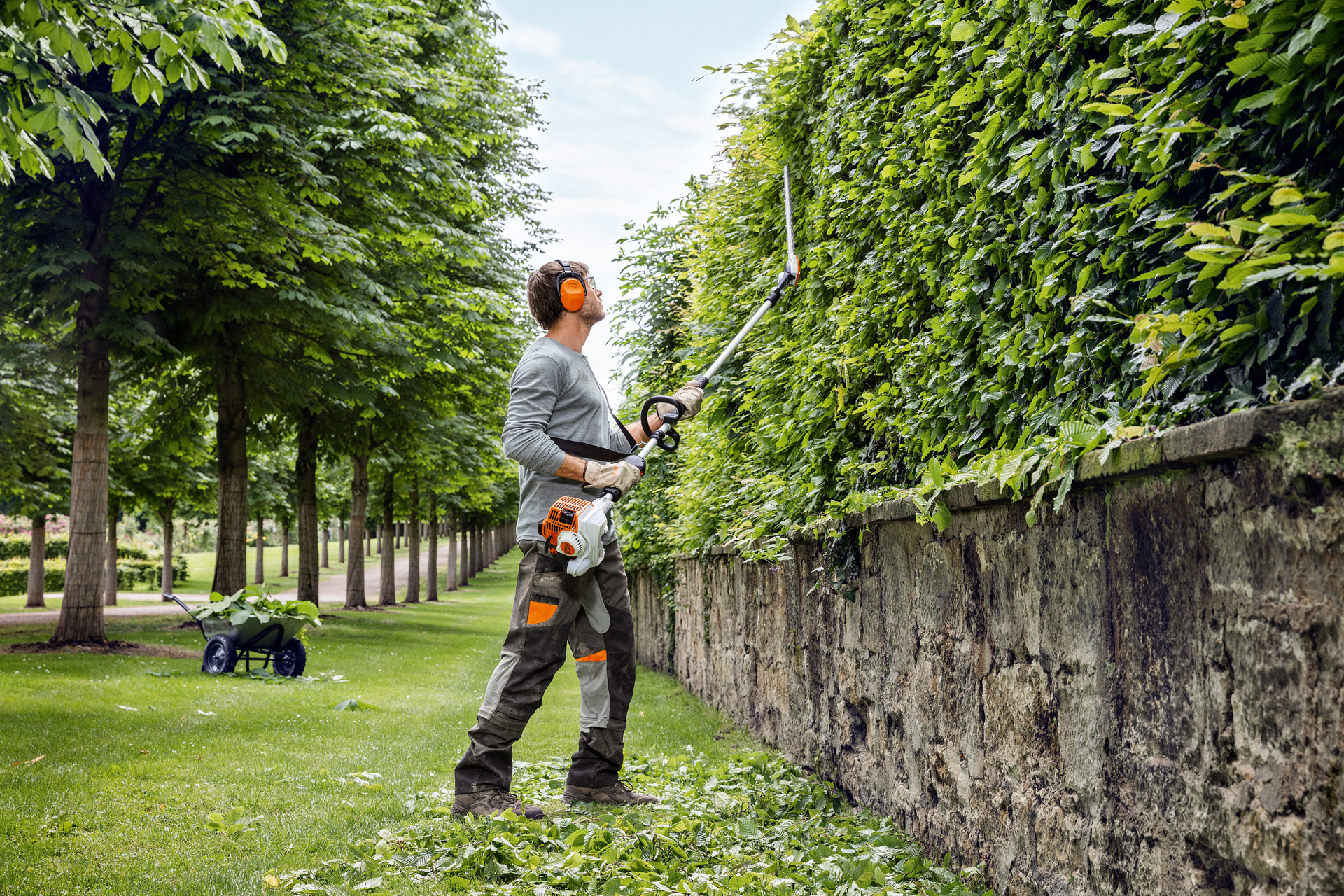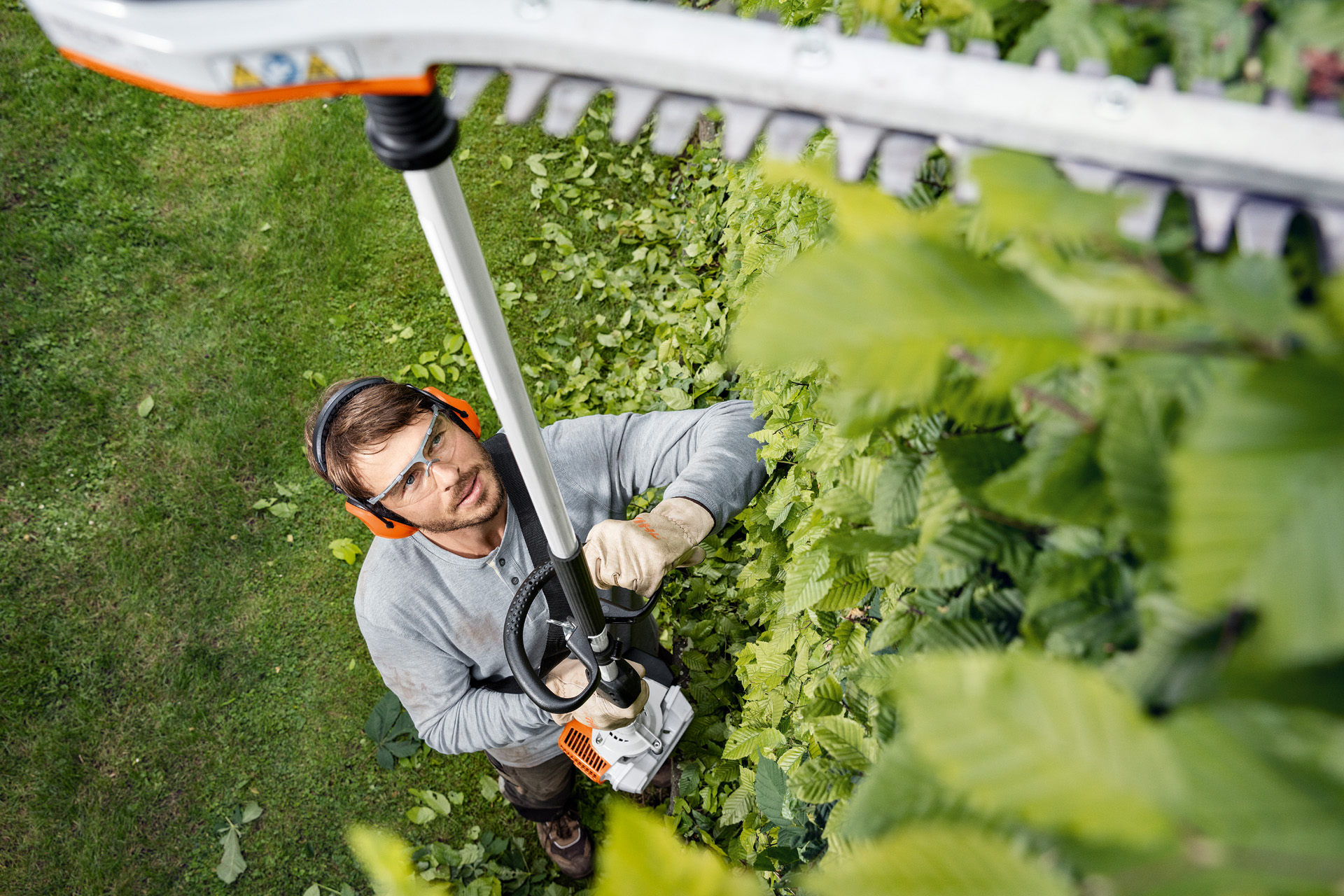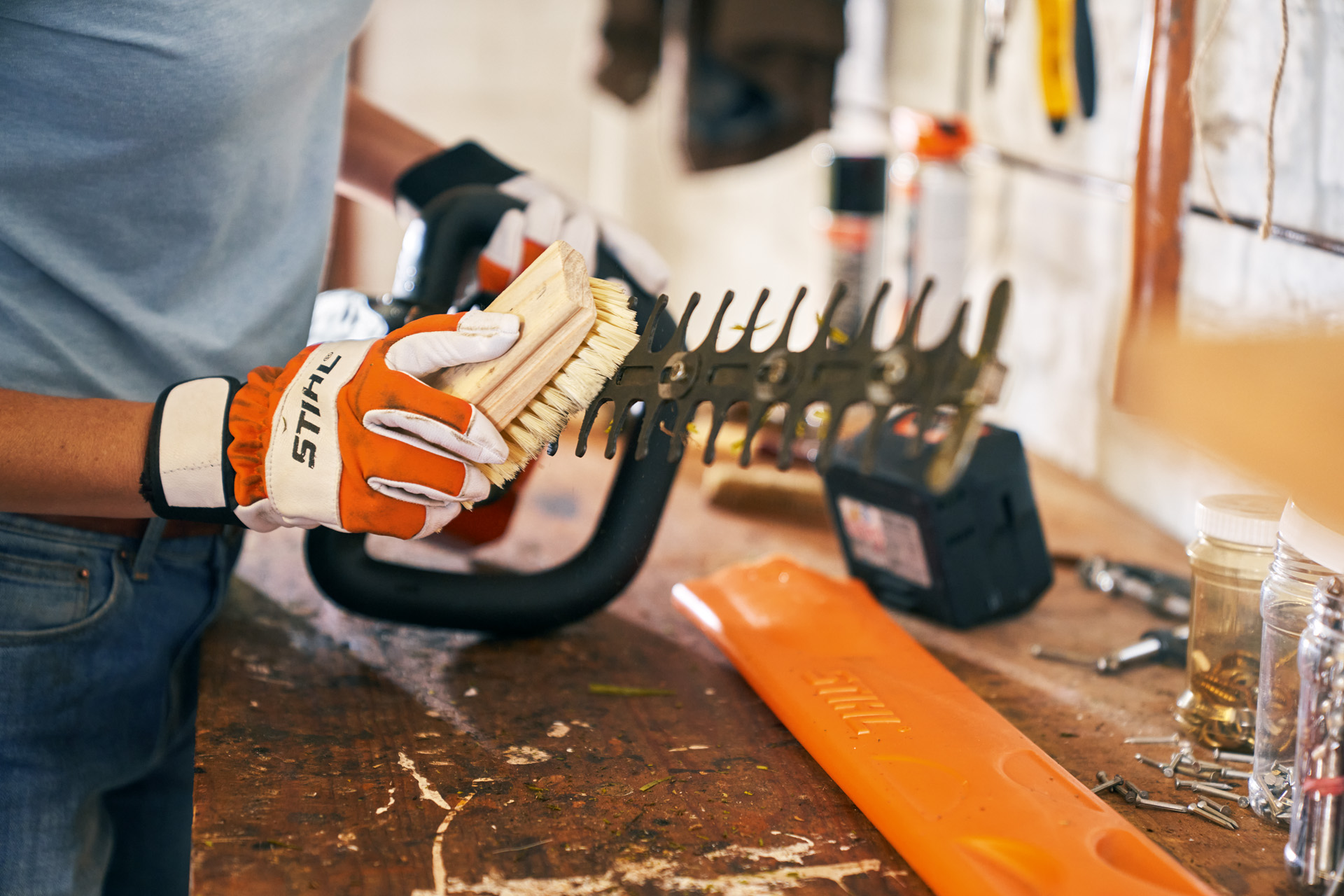Trimming hedges: turn your privacy screen into a living feature wall
A beautiful and healthy hedge makes a perfect frame for any garden. We have all the tips you need, including how to care for a thuja conifer hedge.
17.07.2023

When to cut your hedge
It’s no surprise that hedges are so popular in our gardens. They provide a natural privacy screen that is also a beautiful green wall. But a hedge needs regular attention, trimming and maintenance to grow into a strong, dense form and to look its best for many years to come. It’s worth knowing exactly when and how to cut your own hedge for the most successful results.
The best time to trim hedges
Some plants benefit from a ruthless chop in February, and others don’t need cutting back until later in the year. For particularly fast-growing plants, or if you just want a really neat hedge, you should actually trim twice a year.

Prune and rejuvenate overgrown hedging in February
From the middle to the end of February, before they set bud, hedging plants are not yet full of sap and so can take some generous trimming if needed to keep them in check. What’s more, there won’t yet be any nesting birds to disturb in the branches. Now is the ideal time for trimming hedges such as box, thuja and coniferous cypress.
Cutting hedges back early in the year encourages strong new growth, particularly in hornbeam and field maple. This means it’s also a good time to tackle overgrown hedging that needs dramatic reshaping or rejuvenating. If you have a very overgrown hedge, it’s advisable to prune it back hard only on one side at first, so the plants recover a little before trimming back the other side next February.
Prune flowering hedges after they bloom
To prune flowering hedges such as forsythia, viburnum and jasmine, you’ll need to wait until later in spring, letting them flower before you trim. You'll need to make sure you don’t disturb any wildlife though - always check before trimming as it is illegal to remove, damage or destroy an active nest.
Many hedges also get a second flush of flowers in summer, and these can be trimmed again after blooming at the end of June or start of July if it is not too hot. But remember, this second trimming should be light and only to keep your hedging tidy.
Pruning at the end of summer
August is the right time to trim your beech, privet and evergreen hedging. Beware with conifers, though, as leaving trimming too late after this month can cause permanently bare patches.
Hedge trimming and the law
There are legal considerations that must be taken into account when trimming hedges. In the UK, the Wildlife and Countryside Act of 1981 states that you may not cut a hedge back if you know there is a nest present and if cutting the hedge will damage or disturb the nest. These rules are very important for protecting wildlife, but they don’t prevent you from trimming your hedge: just be certain there are no nests in it first.
Hedge trimming in autumn
Most hedge pruning should be done in the warmer months. However, some hedges such as Yew or Hawthorn can be pruned in autumn. To avoid damage, work on a frost-free and cloudy day. Wait for hedges that shed their foliage until they have completely lost their leaves. Before the onset of winter, the plants extract the remaining nutrients from the leaves and store them in the roots. They will access this supply again in the spring.
The right conditions for trimming hedges
Tip #1
Don’t trim your hedge if it is too hot or sunny. If the leaves growing deeper inside your hedges are suddenly exposed to bright sunlight, their sensitive dermal tissue could get burned.
Tip #2
An overcast, cloudy day is ideal for hedge trimming, particularly in summer.
Tip #3
While spring temperatures are still regularly dropping below -5°C, it’s too early for hedge trimming. Any cuts you make now will take a long time to heal, and the cold will affect thin branches, in particular, making them brittle and weak.

When should I cut back young hedges?
Before a hedge is established, trimming and pruning is particularly important to make sure your plants are strong, dense, and the right shape for your garden. For the first 2–3 years, hedging shrubs such as field maple, hornbeam and beech need to be cut back by up to a third at the shoot tips early on in the gardening calendar to encourage plenty more branches to grow.
Conifers and evergreen trees (such as thuja, cypress, bay and yew) need to be left untouched for a year to grow well. From the second year onwards, cut the side shoots back every year. Once they reach the desired height, cut off the leading shoot.
When is hedge trimming legally permitted?
The Wildlife and Countryside Act of 1981 prohibits you from cutting back hedges if you know there are nests present, in order to protect animals and birds. With this in mind the RSPB recommends not cutting your hedge between March and August. If you need to trim hedges during this time, just make sure you check for nesting birds before starting. If there are active nests in the hedge you should leave it until the nest is no longer in use.
How often should I trim my hedge?
For most hedging plants, it’s worth cutting them to your preferred height and width in the middle to end of February. Then in summer they just need to be lightly pruned.
How often do particular hedge plants need to be trimmed?
- Once a year: yew, barberry, cherry laurel, thuja and cypress.
- Twice a year: privet, hornbeam, field maple and common beech.
Trimming your hedge stimulates growth each time you do it. Frequent but light trimming means it will grow more dense over time provided that it gets enough water, warmth and light.
Rule of thumb for trimming hedges: You should trim your hedge about twice a year – though a very formal box or privet hedge, for example, might need trimming three times for the best effect. Start with a big spring chop in February or early March: give the hedge a really good trim and cut it into shape. If you start to notice some untidy leaf growth in summer, you can get the trimmer out to keep the hedge in shape. New growth can be cut back by a good two-thirds to remove wayward shoots.

Tips and techniques for hedge maintenance
Keeping your hedge neatly trimmed encourages growth and keeps the hedge looking dense and healthy. These tips will help you to avoid bare areas and irregular hedges.
On side shoots only, cut back new growth by two thirds. Leave main stems to grow until the hedge reaches the desired height. The only way to rejuvenate an irregular, patchy or misshapen hedge is with radical hard trimming and then reshaping. Take care with conifers here, though, as they will not put out new growth if you cut them all the way back to the wood. The only exception to this rule is the yew, which can withstand even brutal pruning.
Be aware that some plants, such as thuja and yew, can trigger allergic skin reactions, so you should always wear gloves when trimming these hedges.
Do not trim your hedge when it is too hot or sunny, as there is a danger that the freshly cut surfaces will dry out and die. The same applies if it is too cold. We don't recommend trimming in sub-zero temperatures as the cuts will take a long time to heal, and the cold will weaken thinner branches.
For a good straight cut, it’s helpful to have a guide edge to follow that runs parallel to the hedge. This could be the edge of the lawn or a kerbstone – you could put up a taut string between two stakes to keep you in line. Hold the hedge trimmer level as you work. You should step back every so often to check from a distance how the hedge is shaping up. This makes it easier to see if you are actually trimming straight or not.
For a lush look from top to bottom, go for a slightly wedged shape when trimming your hedge: wide at the bottom and narrower at the top. This is so that light reaches the lower branches; otherwise, they could lose their leaves for good. Always make sure that the hedge is not wider at the top than the bottom - if the bottom is too narrow, it will suffer from being constantly in shade.
When you plant a new hedge, it won’t need trimming initially. In its second year after planting, you can trim the hedge back to the shape you want. Leave the main stem alone until the hedge has reached its intended height, and cut all other stems back by up to half.
The solution for improving fullness in the appearance of a hedge is generally simple: plenty of light. Small gaps will quickly close up if they get enough light – so remove some surrounding branches or other growth that is shading the gap. For a larger space, fix a bamboo cane or other support across the gap and tie a nearby branch into it. The trained stem will follow the cane and grow in place.
After hedge trimming, remember to dispose of the clippings. If leftovers remain on the lawn, they will obstruct its growth and may result in bald spots. It is best to sweep the green clippings together with a fan rake or remove them with a cordless blower, such as the STIHL BGA 57. Alternatively, before trimming the hedge, you can spread out a textile underlay such as an old bed sheet to collect the green clippings. This saves a lot of work, especially in hedges with very small leaves such as boxwood, because the cuttings can be collected and disposed of so easily.
How tall can I grow my hedge?
The permitted height of a hedge depends on its location. In many places, two metres is the maximum. Contact your local council to avoid any problems.

Trimming thuja hedges
Thuja, also known as arbor vitae or western red cedar, is hugely popular as hedging. No wonder, given that as well as creating a year-round privacy screen for your garden, the evergreen plants are both frost-resistant and windproof. It is also a fast-growing variety, meaning that even small plants will become almost-impenetrable hedges in no time. We have put together some thuja hedge care advice.
When to trim thuja hedges
Generally speaking, you can trim thuja at any time of year, as long as conditions aren’t frosty: between April and September is ideal. Much of this is nesting season, so remember to check for nesting birds before you start trimming, as they are protected by law. If there are nests, very light shaping of hedges is fine, but take care not to disturb the wildlife. To ensure a tidy look through the season, you can trim your thuja three times a year – at the start of April, end of June, and end of August – if you prefer to tackle your trimming once a year, the best time is in early summer, around the end of June. Avoid cutting your plants back after the end of September; otherwise, new shoots will not grow back before seasonal frosts return, and your plants may be damaged.
Hedge Pruning

Cutting back hard
If your thuja becomes too tall, dramatic cutting back may be necessary – but it should, in general, be avoided. Effective trimming 1-3 times a year should be sufficient to keep your plants in the required shape and protect healthy growth. Radical pruning puts future new growth at risk and, in a worst-case scenario, could lead to you losing the plant.

Thuja topiary
The right tools make it easy to trim your thuja into intricate shapes. With an easy-to-manoeuvre power tool such as the STIHL HSA 50 cordless hedge trimmer, you can create hedging spheres or spirals in no time. Gently trimming off any protruding shoots three times a year will keep them looking great. Do this at the start of April, end of June (if growth has slowed), and the end of August.
Hedge trimmers and long-reach hedge trimmers
When it comes to trimming hedges or freestanding topiary, you need the right tool – STIHL hedge trimmers and long-reach hedge trimmers help you whip any hedge or shrub into shape. Whether you’re a landscaping pro or a home gardener, you'll find the right tool for every task in the extensive STIHL range.
Hedge trimmers
Our hedge trimmers were created with professionals in mind, so they have been effectively designed and built for long continuous use. The same advantages apply when trimming in your own garden too. Our hedge trimmers really come into their own when working on hip to chest-height hedges; their ease of handling lets you work precisely so you can even create intricate topiary shapes with your trimming.
Long-reach hedge trimmers
If you have a particularly wide or high hedge and need more scope, we recommend a long-reach hedge trimmer. Available in short or long shaft versions, they are ideal for landscape maintenance professionals and ambitious home gardeners alike.
Technique for cutting medium hedges with a hedge trimmer

For trimming the vertical sides of a hedge: Trim upwards in an arcing movements to cut the flat faces of the hedge – remember to slightly taper towards the top, particularly on high hedges.

For trimming the top of a hedge: As you cut across the top, move the cutter bar horizontally at an angle of zero to ten degrees. Tip: if you use crescent-shaped movements, the clippings will fall away from the hedge. You can also use our catcher plate on selected hedge trimmer models to help you remove cuttings from the top of the hedge.
Technique for using a long-reach hedge trimmer on a high hedge
What is the difference between long-reach hedge trimmers and standard hedge trimmers?

STIHL hedge trimmers
STIHL hedge trimmers have been developed specifically for long rows of densely grown hedging. The double-sided cutter is ideal for pruning as well as horizontal and vertical trimming.

STIHL long-reach hedge trimmers
The extended shaft of a STIHL long-reach hedge trimmer means you can trim particularly tall, long or wide hedges. The cutter bar can be rotated by up to 145°, so you can set any angle with ease.
From trimming to topiary
Some gardeners opt for annual trimming to keep things looking neat, while others release the artist within on their shrubs and bushes.
Cutting geometric shapes
Set up taut strings or a frame of wooden slats to help cut precise geometric shapes, even on plants with a tall trunk. Just rotate the frame around the plant, trimming off all visible shoots as you go – it’s as simple as that.
Interesting facts about shaping bushes
What is topiary?
The term topiary is derived indirectly from the Latin word topiarius, meaning ornamental garden, and today it's used to refer to the shaping of plants. A topiary is simply a plant that has been intricately shaped, and the skill of doing it is widely considered an art form.
Which plants are best for topiary?
Dense shrubs such as box and yew are ideal.
How do you shape a hedge?
The main “bones” of the desired shape are created with strong branches, which become finer and finer as each stem progressively splits. Tie in flexible branches with wire to train them in the right direction for your preferred shape.

How to trim shrubs and bushes into creative shapes
For animals and other creative shapes, it’s best to use a wire mesh structure. This should be installed around the entire shrub, then you can simply cut the shrub just outside the shape of the mesh.
- You’ll need hand-held, sharp secateurs or another tool that you can cut precisely with.
- Cut back all protruding stems several times a year to encourage the plant to fill out.
- You’ll probably need to wait a couple of years, but eventually, your project will make a striking garden sculpture.
Summary: trimming hedges
- Trimming overgrown hedges is ideally done in spring, shortly before new growth starts.
- For flowering hedges, trimming should only take place after they have finished blooming.
- If you’re planning to trim hedges between March and September, make sure that there are no birds’ nests or other breeding creatures in the hedge.
- The best weather for hedge trimming is neither too hot nor frosty, and with no strong direct sunlight.
- Cut new stems back by two thirds.
- Thuja should be pruned 1-3 times a year. Avoid pruning in frost, when it is very sunny, or if the hedge is wet. Thuja does not usually tolerate dramatic pruning.
- Use a hedge trimmer for chest-height hedges and a long-reach hedge trimmer for tall hedges.
- Create topiaries from shrubs and bushes using homemade frames.




